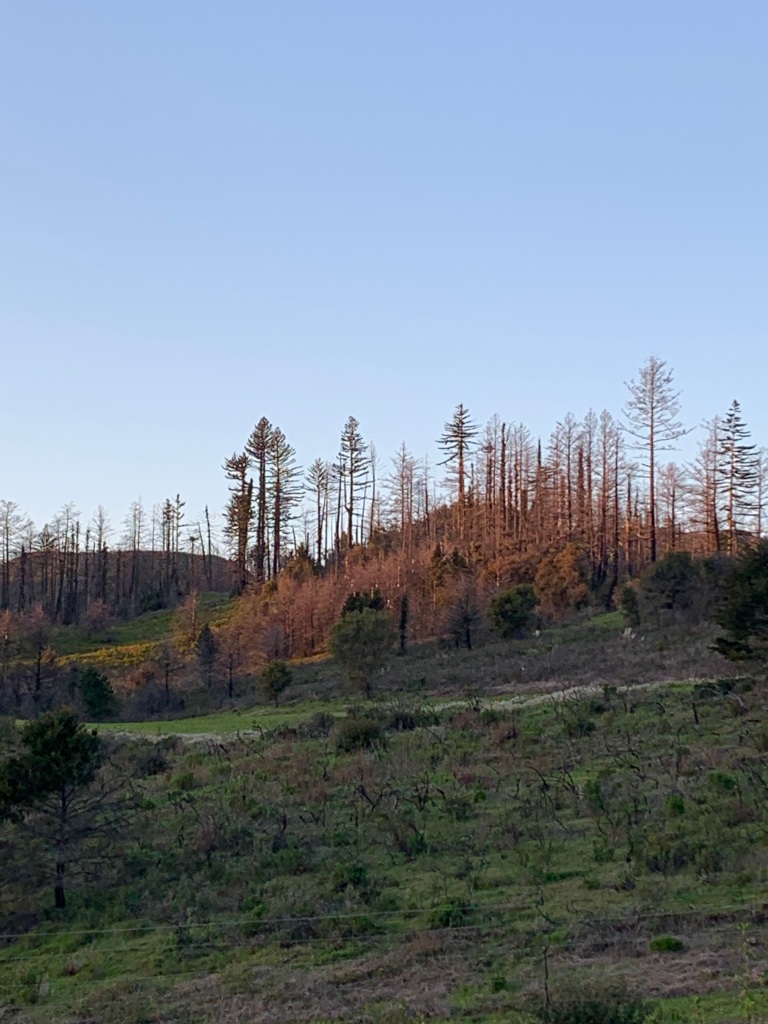Wild blackberries are blooming big time. Their brambly tip-rooting canes are sprouting new leaves and are festooned with bright white five-petalled flowers. In rare years, they make tasty, juicy berries, but mostly the weather turns hot and dry, and the fruits are seedy/not-so juicy. Currently, they are making pollen and nectar for the emerging bumble bees, while we dream of the tasty fruit. Wild blackberries are the dominant wildflower right now on the farm, creating hedgelets along all the fences ‘cause that’s where we can’t mow them too much. They arch out from there onto our fence-side trails: trip hazards!
Wild Lilac
Soon, there will be more wildflowers – spring is on the verge of letting loose! Nearby, on south-facing shallow-soiled spots, the poppy displays are epic splashes of orange, bigger than any recent year. Across Molino Creek, on that steep south facing slope, a large patch of poppy orange has erupted where before the fire there had been shrubs. I’m looking forward to the woodland iris displays, though they are getting overtaken by post-fire shrubs like blue blossom (Ceanothus), which is starting to blossom as well. In about 2 weeks, there will be miles of blue blossom shrubs blooming about 5 feet high across at least half of the 85,000-acre burn footprint of the 2020 CZU Lightning Complex Fire. Imagine a sea of powder blue, framed by glossy light green leaves…thousands of acres of rolling wild lilac scent wafting headily, luring you to just stand still and gaze.
Ridge Guardians
More than a few of the noble ridge-line tree skeletons have fallen, but many remain silhouetted on the ridgelines. The redwoods have enjoyed the rain and are recovering from drought and fire with luxurious new growth; the ones that burned hotter sprouting from only their trunks…others from their branches…and all of them from the base of their trunks with 5’+ tall sprouts sprinting skyward. And everywhere, between it all, so very green and lush, but the ground is getting drier.
Drying Out
Even with all the rain, the ground is starting to dry out. Once the rain stops, even for a little while, the long days and the strong breezy days we’ve been having make for quick dry soil. The upper 2” of soil is dry, dry, but below it is still pretty moist. Gophers are awaking and their soil throws are starting to appear, moist piles burying the surrounding lush grass. Roots pump moisture from deep in the earth and plants grow quickly to blossom and seed before the last moisture is gone and the long dry summer sets in.
Green Manure
The most proud bolt is in cover crop land. Thick bell bean stalks sport rows of big white flowers and flapping succulent leaves. Twining ferny leaved vetch climbs up those stalks. Pert sharp leaves of oats grow in thick forests through it all, promising tons of tough stems for future spongy soil organic matter.

Along Come the Mowers
Back and forth, hither and yon, the mowers must mow. Behind the machines, dense mats of sweet-smelling chopped up vegetation, either to be tractored into the soil or left on top as mulch, protecting the earthworms from sunburn. We rush to mow the farm fields and the orchard understory to keep the plants from sucking up the soil moisture, to keep the water for the crops to delay irrigation for as long as we can.
It’s suddenly become a busy time around the Farm. I suspect the spring is revving everyone’s energy about now. Keep calm and plod forward!
-from my weekly blog also posted at Molino Creek Farm’s website.





